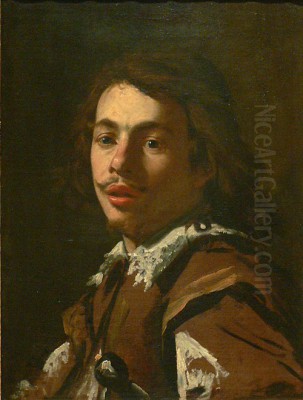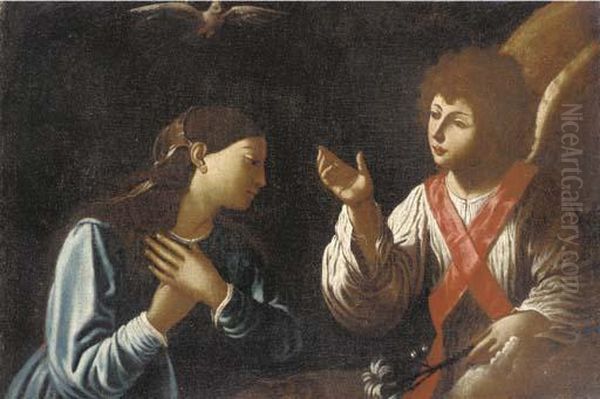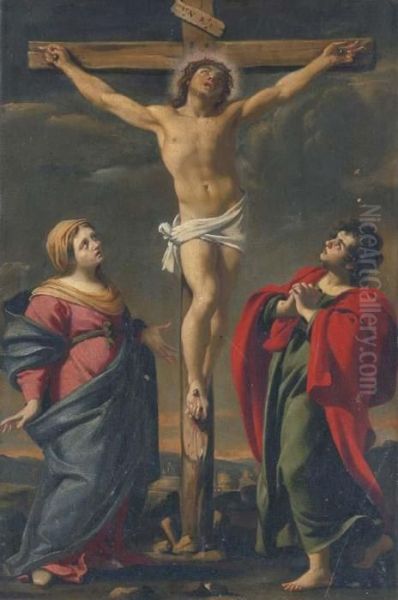
Aubin Vouet, born in Paris in 1595 and deceased there in 1641, stands as a notable figure within the vibrant landscape of French Baroque art. Though often perceived through the luminous lens of his elder brother, the celebrated Simon Vouet, Aubin carved out his own identity as a painter, contributing significantly to the artistic currents of the early seventeenth century. His life and work unfolded primarily between the artistic hubs of Paris and Rome, reflecting the dynamic exchange of ideas that characterized the era. As an artist navigating the complex world of patronage, influence, and familial connection, Aubin Vouet's story offers valuable insights into the workings of the Baroque art scene in France.
His career, though shorter and perhaps less documented than Simon's, reveals an artist engaged with the dominant stylistic trends of his time, particularly the dramatic naturalism emanating from Italy. He produced works primarily focused on religious narratives and portraiture, often imbued with a vivid sense of colour and dynamic composition that aligns with the burgeoning French Baroque aesthetic. Understanding Aubin Vouet requires acknowledging his connection to Simon while also appreciating his individual contributions and artistic choices.
Early Life and Artistic Formation
Born into an artistic family, Aubin Vouet's path seemed destined towards painting. His father, Laurent Vouet, was himself a painter in Paris, providing the initial artistic environment for both Aubin and Simon. Growing up in this milieu meant early exposure to the techniques and traditions of painting. It is highly probable that, like Simon, Aubin received his foundational training directly from their father, learning the rudiments of drawing, composition, and paint handling within the family workshop.

This familial training ground was crucial in seventeenth-century France, where artistic skills were often passed down through generations. The Vouet household would have been a place of constant artistic activity, fostering a competitive yet supportive environment. While Simon, four years Aubin's senior, demonstrated prodigious talent early on, Aubin developed his skills alongside him, inevitably absorbing influences from his brother as well as their shared paternal instruction. This early period laid the groundwork for his later career, instilling in him the technical proficiency necessary to engage with the demanding artistic standards of the time.
The Roman Sojourn: Influence and Activity
Like many ambitious Northern European artists of his generation, Aubin Vouet sought the enriching artistic experiences offered by Italy, particularly Rome. He is documented as being in Rome around the early 1620s, a period when the city was the undisputed centre of the European art world. This was a critical phase in his development, exposing him directly to the masterpieces of the High Renaissance and, more importantly, the revolutionary trends of the early Baroque. His brother Simon was already a significant presence in Rome, and Aubin joined him there, likely working in close proximity.
The most profound influence during this Roman period was undoubtedly the legacy of Michelangelo Merisi da Caravaggio. Though Caravaggio himself had died in 1610, his powerful naturalism, dramatic use of chiaroscuro (strong contrasts between light and dark), and emotionally charged depictions of religious scenes continued to dominate Roman painting. Artists known as the Caravaggisti, both Italian like Orazio Gentileschi and Artemisia Gentileschi, and foreign like the Dutchman Gerard van Honthorst or the French Valentin de Boulogne, perpetuated and adapted his style. Aubin Vouet absorbed these lessons, incorporating tenebrism and a heightened sense of realism into his work.
Beyond Caravaggio, Rome offered a rich tapestry of styles. The classicizing tendencies of the Carracci school, represented by Annibale Carracci and his followers like Domenichino and Guido Reni, provided a counterpoint to Caravaggio's raw naturalism, emphasizing ideal beauty, balanced compositions, and clarity. Aubin would have encountered these diverse approaches, navigating the artistic debates between naturalism and classicism. His time in Rome was not just about observation; he was actively painting, sometimes in collaboration with Simon and Simon's wife, the painter Virginia da Vezzo. Works like David with the Head of Goliath strongly reflect this Roman, Caravaggesque influence. He may also have formed connections with other artists active in Rome, such as Andrea Sacchi, another painter navigating the currents of Baroque style.
Artistic Style: Between Caravaggism and French Sensibility

Aubin Vouet's artistic style is characterized by its engagement with Italian Baroque models, particularly Caravaggism, filtered through a developing French sensibility. His works often feature the dramatic lighting and intense realism associated with Caravaggio and his followers. Strong contrasts between illuminated figures and dark, ambiguous backgrounds create a sense of immediacy and psychological depth, particularly evident in his religious narratives. He favoured robust, tangible figures, grounding sacred stories in a relatable human reality.
Compared to his brother Simon, especially Simon's later French style, Aubin's work sometimes appears more directly indebted to the raw power of early Baroque naturalism. While Simon increasingly adopted a lighter palette, more idealized forms, and a graceful elegance suited to French courtly tastes after his return from Italy, Aubin often retained a stronger emphasis on chiaroscuro and physical presence. However, his work is not merely imitation; it possesses a distinct character.
Some sources suggest Aubin placed a greater emphasis on detail and the careful rendering of textures compared to the broader, more decorative approach Simon often employed in large-scale commissions. His compositions, while dynamic, could also incorporate a degree of classical balance, preventing the drama from becoming overwhelming. He demonstrated skill in rendering expressive faces and gestures, conveying the emotional core of his subjects, whether biblical heroes or saints. His colour palette, while capable of dramatic contrasts, could also be rich and nuanced, contributing to the overall impact of his paintings.
Collaboration within the Vouet Circle
The concept of the artist as a solitary genius often overshadows the collaborative reality of many historical art workshops. The Vouet family circle provides a prime example of this collaborative environment. Aubin Vouet frequently worked alongside his brother Simon, particularly during their time in Rome and likely continuing after Simon's return to Paris in 1627. This collaboration extended beyond the two brothers; Simon's wife, Virginia da Vezzo, an accomplished painter in her own right, was also an active participant in the workshop's output.
Documentary evidence and stylistic analysis suggest joint efforts on several canvases. Paintings depicting biblical heroines like Judith or heroes like David are often cited as products of this collaborative synergy. In such works, it can be challenging to definitively disentangle the individual hands, as family members working closely together often developed complementary skills and a shared visual language. Virginia da Vezzo, for instance, is known to have run a studio and even involved her daughters in teaching, highlighting the integrated nature of art production and family life.

Aubin's role within this structure was significant. He was not merely an assistant but a skilled collaborator, contributing his own talents to the workshop's prestigious output. This close association with Simon, while potentially limiting the independent recognition of his own name, placed him at the heart of one of the most influential artistic enterprises in early seventeenth-century France. The Vouet workshop, led by Simon but involving Aubin, Virginia, and numerous pupils, was instrumental in shaping the course of French Baroque art.
Major Works and Thematic Focus
Despite the passage of time and the loss of works, several key paintings by Aubin Vouet survive, showcasing his style and thematic preoccupations. His oeuvre demonstrates a strong focus on religious subjects, particularly dramatic episodes from the Old and New Testaments, which were popular themes during the Counter-Reformation era, emphasizing piety, martyrdom, and divine power.
One of his most recognized works is David with the Head of Goliath. Several versions or related compositions exist, with one notable example housed in the Musée des Beaux-Arts et d'Archéologie de Besançon. This painting exemplifies his engagement with Caravaggism: the young hero David emerges from deep shadow, dramatically lit, holding the gruesome head of the giant. The intense realism, the play of light and shadow, and the psychological focus are hallmarks of the style he absorbed in Rome. The theme itself, representing the triumph of virtue and divine aid over brute force, was resonant in the period.
Another significant theme involves powerful female figures from the Bible, such as Judith. Often depicted holding the head of Holofernes, Judith was another popular subject symbolizing courage, faith, and the defeat of tyranny. As mentioned, works on this theme are sometimes considered collaborations involving Aubin, Simon, and Virginia da Vezzo, reflecting the shared interests and production methods of the Vouet workshop.
His Saint Michael Vanquishing the Devil, a dynamic composition showing the archangel triumphing over evil, has a fascinating history. Once part of the collection of the Séminaire de Québec in Canada, it later entered the Musée de la civilisation in Montreal. This work highlights his ability to handle complex, multi-figure compositions with energy and force, typical of Baroque dynamism. The subject matter, emphasizing divine justice and the power of heaven, was a staple of Catholic art.
Aubin Vouet also painted scenes from the lives of saints. Saint Sebastian Tended by Saint Irene depicts the popular saint being cared for after surviving the first attempt on his life by Roman archers. This theme allowed artists to combine religious piety with the depiction of the idealized human form and tender emotion. Another important work is Cornelius at the Feet of Saint Peter (1639). This painting gained renewed attention when it was exhibited at the Mobilier National in Paris in 2024, having been one of the treasures saved and restored after the tragic fire at Notre Dame Cathedral in 2019. It showcases his mature style, blending Roman influences with a clarity perhaps more aligned with developing French tastes.
Aubin Vouet and His Contemporaries
Aubin Vouet's artistic journey unfolded within a rich network of contemporaries, both allies and rivals. His most significant relationship was, of course, with his brother Simon Vouet. Simon's towering reputation as "Premier Peintre du Roi" (First Painter to the King) under Louis XIII cast a long shadow. Simon's success in bringing a sophisticated, Italianate Baroque style back to France and adapting it for royal and ecclesiastical patrons made him the dominant force in Parisian art from the late 1620s until his death in 1649. Aubin operated within this sphere of influence, benefiting from the connection but also inevitably compared to his more famous sibling.
Their father, Laurent Vouet, represents the earlier generation from which they emerged. In Rome, Aubin moved in circles influenced by Caravaggio and populated by artists like Valentin de Boulogne, who specialized in Caravaggesque genre scenes and religious subjects. He would also have been aware of the more classicizing trends championed by artists associated with the Bolognese school, such as Guido Reni, Domenichino, and Guercino, whose works were highly sought after. The presence of other major French artists in Rome during the early seventeenth century, such as Nicolas Poussin and Claude Lorrain, created a stimulating, if competitive, environment, though direct interactions with Aubin are not heavily documented. Poussin, in particular, would develop a rigorous classical style that offered a distinct alternative to the more decorative Baroque favoured by Simon Vouet.
Back in Paris, the art scene was dominated by Simon Vouet's workshop and its influence. Aubin was part of this central hub. Simon trained a generation of painters who would define French art for decades, including Charles Le Brun, Eustache Le Sueur, and Pierre Mignard. Le Brun, in particular, would eventually eclipse Simon Vouet's influence, becoming the artistic director under Louis XIV and championing a grand, state-controlled classicism through the Royal Academy of Painting and Sculpture. While Aubin was not directly involved in these later power struggles (he died in 1641, before the Academy's founding in 1648), he was part of the milieu from which these figures emerged. Other significant French contemporaries included Philippe de Champaigne, known for his austere portraits and religious works influenced by Jansenism, and Laurent de La Hyre, who developed a refined, elegant style often termed "Parisian Atticism." Aubin Vouet's career intersected with these diverse talents, reflecting the multifaceted nature of French art in the early Baroque period.
Legacy and Artistic Influence
Assessing the legacy of Aubin Vouet requires acknowledging his position relative to his brother Simon. While Simon is rightly celebrated as a pivotal figure who transformed French painting by introducing and adapting the Italian Baroque style, Aubin's influence was more subtle and largely intertwined with the Vouet workshop's collective impact. He did not establish an independent school or train major pupils in the way Simon did. Consequently, his individual mark on the subsequent development of French art is less distinct.
However, this does not diminish his contribution. As a skilled painter and active collaborator within the Vouet circle, he played a part in producing the body of work that helped establish the Baroque style in France. His paintings, particularly those reflecting his Roman experience and engagement with Caravaggism, contributed to the dissemination of these influential ideas north of the Alps. His surviving works serve as important examples of early French Baroque painting, demonstrating how Italian innovations were absorbed and interpreted by French artists.
His collaboration with Simon and Virginia da Vezzo highlights the importance of workshop practice and familial artistic dynasties in the seventeenth century. His works, when studied alongside Simon's, offer insights into the variations and shared characteristics within a major artistic enterprise. Furthermore, the survival of key works like Cornelius at the Feet of Saint Peter and Saint Michael Vanquishing the Devil, especially their connection to significant institutions and events like the Notre Dame fire restoration, ensures his name continues to be recognized.
The loss of a portion of his oeuvre, potentially during the French Revolution which saw the destruction or dispersal of much religious and aristocratic art, has undoubtedly impacted the modern assessment of his career. Nevertheless, the extant paintings confirm his talent and his role as a participant in the vibrant artistic exchanges between Italy and France during a formative period. He remains a significant, if secondary, figure in the grand narrative of French Baroque art.
Conclusion: A Painter in Context
Aubin Vouet's life and career offer a compelling case study of a talented artist working within the orbit of a more famous relative during a period of significant artistic transformation. Active from roughly 1620 until his death in 1641, he witnessed and participated in the importation of Italian Baroque ideas into France, particularly the dramatic naturalism of Caravaggio, which he encountered firsthand during his time in Rome. His paintings, characterized by strong lighting, robust figures, and emotionally charged religious themes, reflect these influences while also displaying a distinct artistic personality.
His close collaboration with his brother Simon Vouet and sister-in-law Virginia da Vezzo places him at the centre of one of the most important artistic workshops in seventeenth-century Paris. While this association meant his individual fame was often eclipsed by Simon's, it also ensured he was involved in producing works that shaped the course of French art. His known paintings, such as David with the Head of Goliath, Saint Michael Vanquishing the Devil, and Cornelius at the Feet of Saint Peter, stand as testaments to his skill and his contribution to the French Baroque. Though perhaps destined to remain "in the shadow of genius," Aubin Vouet was a noteworthy painter whose work merits attention for its quality and its place within the rich artistic tapestry of his time.